Successfully Start Business in Japan by Mastering Politeness in Japanese Business Etiquette
ASIA BUSINESS FACTSJAPAN
River Chan
8/18/202520 min read
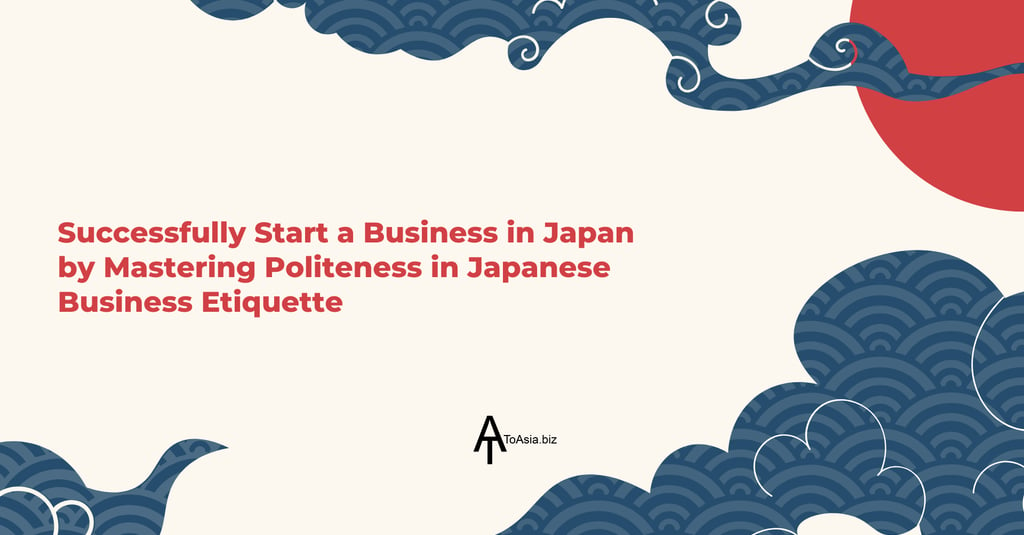

Entering the Japanese business world can be both exciting and challenging for Western professionals. Japan’s culture places great emphasis on politeness, respect, and formality, which permeate every business interaction. Small gestures and manners that might seem trivial back home can significantly impact your first impression in Japan. This guide will help you navigate strictly business-related etiquette – from the proper greeting to the after-work dinner – ensuring you show respect and avoid faux pas when dealing with Japanese colleagues or clients. By understanding these customs, Western businesspeople and management teams can build trust and smoother partnerships in Japan.
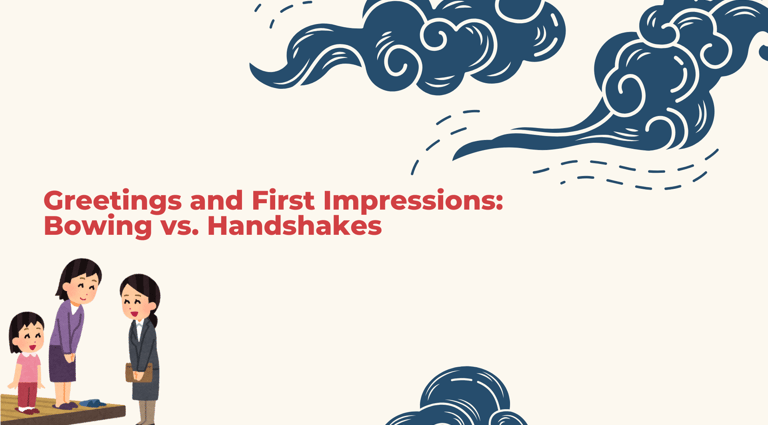

Greetings and First Impressions: Bowing vs. Handshakes
The first moments of a meeting are crucial. In Japan, a bow is the traditional greeting, even in business. Unlike in the West where a firm handshake is standard, many Japanese will bow upon meeting; some may offer a handshake to foreigners, sometimes even doing both (a handshake with a slight bow) as a compromise. As a rule of thumb, follow your host’s lead. If they bow, bow back; if they extend a hand, you can gently shake (noting that Japanese handshakes are often lighter in grip than Western ones). When bowing, keep your back straight and bend at the waist with your eyes cast downward as a sign of respect. The depth of the bow matters – a slight 15° nod (eshaku) is casual, a 30° bow (keirei) is common for business greetings, and a deeper 45° bow (saikeirei) signals profound respect or apology. Don’t worry if you’re not perfect; your effort counts. Even a foreigner’s attempt at bowing or politely inclining the head is appreciated by Japanese colleague.
Different types of bows in Japanese business etiquette: the shallow bow (~15°) for casual greetings, the respectful bow (~30°) for most business occasions, and the deep bow (~45°) reserved for deep respect or apologies. As a Westerner, you aren’t expected to execute precise Japanese bows, but showing that you understand their importance demonstrates cultural respect. An American executive once shared how he awkwardly bowed while shaking hands, prompting a friendly chuckle – but the gesture still broke the ice. The key is to be sincere. A genuine, modest bow alongside your “Hello” or “Hajime mashite” (“Nice to meet you”) shows humility and will be met with warm acceptance. Keep in mind personal space, too: the Japanese generally stand a bit farther apart and avoid overly touchy greetings. Save the back-slapping for elsewhere; a courteous bow will do the job.
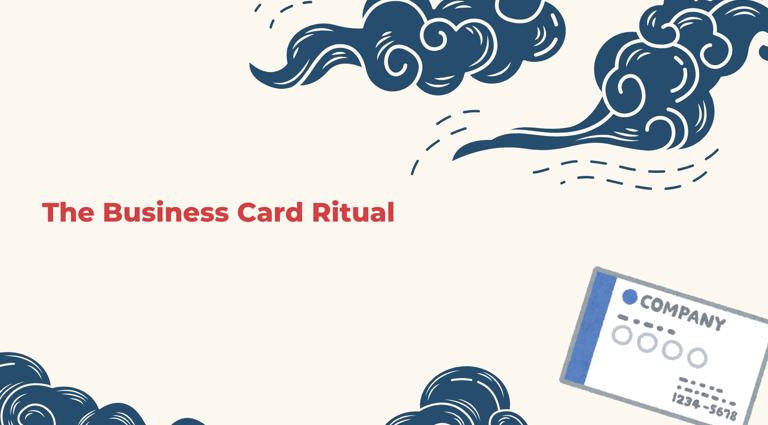

The Business Card Ritual
One of the most important first-impression rituals in Japanese business is the exchange of business cards, or meishi kōkan. To Westerners, a business card is just contact info; in Japan, it’s an extension of the person and their company – to be treated with respect. Expect an almost ceremonial exchange of business cards at the very start of a meeting. Come prepared with a stack of cards – bring far more than you think you’ll need (at least 100 for a week-long trip) and consider having them printed double-sided (English on one side, Japanese on the other) planet. If possible, use high-quality cards and keep them in a nice case; a worn or dog-eared card reflects poorly on your professionalism.
How to exchange cards politely: When the time comes, the most senior person usually initiates the exchange, and cards are traded in order of rank. Offer your card with both hands, Japanese side facing up toward the recipient. Accompany this with a slight bow and a phrase like “Yoroshiku onegaishimasu.” When receiving a card, accept it with both hands as well, and take a moment to look at it carefully, appreciating the name and title. It’s polite to nod or say “Arigatō gozaimasu” (thank you) as you receive it. Never just stuff the card into your pocket or wallet immediately – and certainly do not write on it, fold it, or flick it across the table! These actions would signal disrespect. Instead, place the card gently on the table in front of you for the duration of the meeting (often arranged by seniority, with the highest-ranking person’s card on top) as a reminder of who’s who. For example, one Western manager recounted how he casually slid a stack of cards across the table and shoved the ones he received into his jeans pocket – only to sense the discomfort of his Japanese counterparts. He later learned that in Japan a business card is treated as one’s face; his casual handling came off as dismissive. Don’t make that mistake. Use a proper case to store the cards you receive, and never leave a meeting forgetting someone’s card on the table – that is akin to insulting them by implying they’re unimportant.
Quick tips for business cards:
Present and receive with two hands: This shows respect and attentiveness.
Mind your form: Don’t cover important text with your fingers and ensure the card faces the receiver. Bow your head slightly as you exchange.
Treat cards with care: No scribbling notes on someone’s card or cramming it into a back pocket. Use a dedicated card holder to store them neatly.
Wait your turn: In a group, let the Japanese side guide the order of exchange. Typically, let the senior Japanese executives exchange cards first to avoid accidentally slighting someone of higher rank.
Review and remember: Take a moment to read the card. Pronouncing the person’s name (e.g., “Tanaka-san, pleasure to meet you”) can be a nice touch that shows genuine interest.
By handling meishi properly, you demonstrate that you’re a serious business partner who respects Japanese customs. This small act goes a long way toward building goodwill.
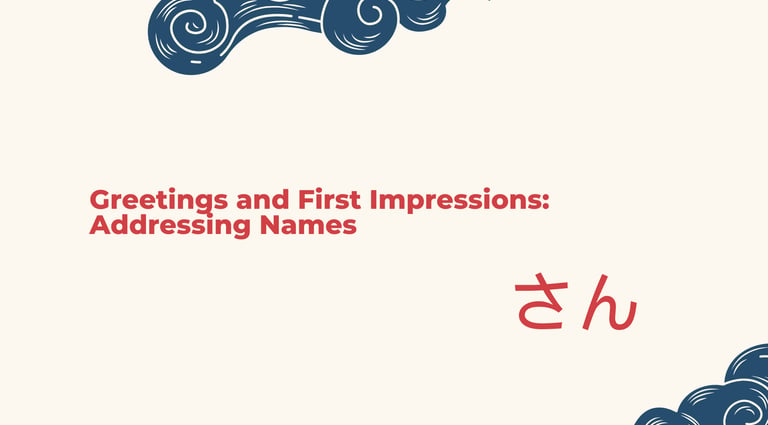

Greetings and First Impressions: Addressing Names
In Japan, use formal addresses until invited otherwise. This means [Last Name] + san (e.g. “Tanaka-san”) rather than first names, as it’s a sign of respect. Avoid calling a Japanese colleague by their first name unless you have a close relationship or they specifically ask you to – which is rare in initial business dealings. When introducing yourself, state your full name and company/position, and offer a slight bow. For example: “Hajime mashite. [Your Name] to mōshimasu. [Your Company] no [Your Title] desu.” followed by “Yoroshiku onegaishimasu,” roughly “I humbly ask for your favor,” a common polite phrase to mark the start of a relationship. Using a few Japanese phrases like these, or a polite “Ohayō gozaimasu” (good morning) when appropriate, can earn you esteem – just pronounce them as best you can and with a smile.
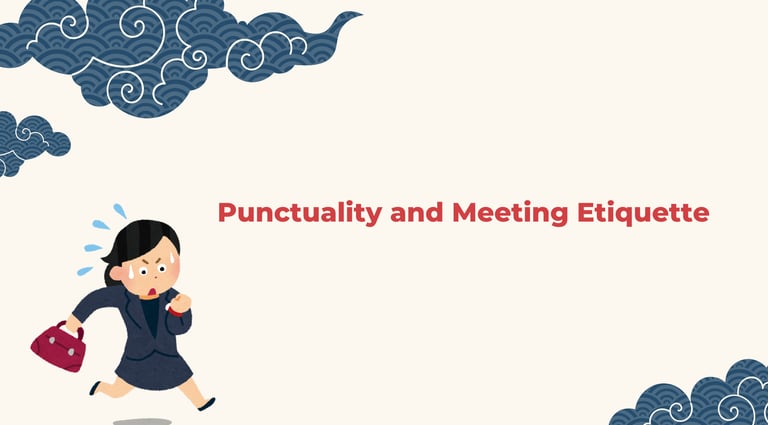

Punctuality and Meeting Etiquette
If there’s one thing to remember about Japanese business culture, it’s punctuality. Being on time – actually, being slightly early – is practically sacred. Meetings in Japan start exactly at the scheduled time and often end as scheduled to the minute. Aim to arrive 10-15 minutes early to any appointment to account for navigation or building security procedures. Arriving early is seen as a sign of respect for others’ time, whereas being late (even by a few minutes) can be seen as disrespectful or disorganized. In case of an unavoidable delay, always call ahead to apologize and inform your counterpart – a sincere apology on the phone (and again in person) is expected if you are late.
Seating and formalities: In a Japanese meeting room, deference to hierarchy dictates seating arrangements. Typically, the guest (you) will be guided to the seat furthest from the door – this is the place of honor with least distraction. The hosts often sit closer to the door. Wait to be invited to sit; don’t just plop down anywhere. It’s polite to remain standing until the hosts have shown you your seat or until the most senior person on the Japanese side has taken their seat. Likewise, in an elevator, you might notice a junior staff member holding the door or standing by the control panel while senior people step in first. These unspoken rules of rank are all part of the business politeness in Japan. As a foreign guest, you aren’t expected to know every nuance, but following the lead of your Japanese counterparts will keep you safe. When in doubt, a little hesitation to observe what others do is wise.
During the meeting: Start with some polite small talk if your hosts initiate it. Initial meetings in Japan can include a bit of formality and pleasantries (weather, your trip, etc.) before diving into business. When it’s time to talk business, remain formal and measured. A few key points to remember:
Be prepared with multiple copies of any documents or presentations for everyone attending. Distributing materials neatly to each person (likely after the initial greetings and meishi exchange) shows foresight and courtesy.
Speak clearly and avoid slang or jargon, especially if not all attendees are fluent in English. If a translator is present, pause often to allow interpretation. Even if not, remember your audience may prefer a slightly slower pace to catch technical terms.
Listen attentively and do not interrupt. In Japan, cutting someone off is very rude. There may be longer pauses in the discussion than Westerners are used to – resist the urge to jump in immediately. Silence can be a sign of thoughtful consideration, not necessarily disagreement.
Non-verbal cues: Be mindful of body language. Avoid intense direct eye contact with senior people, as in Japan prolonged eye contact can feel confrontational. A friendly, calm demeanor works best. Nod to show you’re following along. Keep an upright posture (no slouching or casual sprawling in the chair).
Take notes: It’s perfectly okay – even appreciated – to jot down notes during meetings. Japanese attendees often note key points. Diligent note-taking on your part signals interest and engagement. Just be careful not to stare at your watch or phone; that suggests boredom or impatience.
Patience in decision-making: Western business culture often emphasizes quick wins and rapid decisions. In Japan, decision-making can be slow and methodical. Don’t expect to close a deal in the first meeting; in fact, it’s rare to get a firm decision on the spot. Japanese companies prioritize long-term relationships and consensus-building, so decisions may require multiple discussions and internal consultations. Applying pressure for an instant answer might backfire – it could be seen as aggressive or disrespectful. Be patient and focus on building trust. One American sales manager recounted pitching to a Japanese firm and asking repeatedly if they were ready to sign – the mood soured, and the meeting ended without a deal. He later learned that his pushiness had made his Japanese counterparts uncomfortable. They preferred to deliberate and would convey their answer later, but his insistence had hurt the rapport. The lesson: Tone down the hard sell; give your partners room to consider.
Moreover, learn to interpret a polite “yes.” Japanese communication is famously indirect and aimed at preserving harmony (avoiding saying an outright “no”). Thus, you might not hear “no” even if that’s what they mean. Phrases like “We will examine it” or “That could be difficult” may actually be polite refusals. Even a simple “hai” (“yes”) during your presentation often means “I acknowledge what you said,” not an agreement. As the Japan-America Society notes, a statement that sounds like approval may actually be a courteous disagreement or hesitation. Similarly, Japanese colleagues might express a negative response through subtle cues: vague replies, silence, or a sharp intake of breath through the teeth are ways to convey reluctance without directly saying “no”planet. For example, if you propose a rushed timeline and you hear a polite laugh followed by “This schedule is a bit challenging,” take it as a sign to adjust, not as an invitation to bulldoze through. Reading the air – as the Japanese say “kuuki wo yomu” – is an art. When in doubt, ask open-ended questions and offer face-saving outs. Instead of cornering someone with “Can you do this by next week? Yes or no?”, you might ask “What timeline would you consider comfortable for this task?” This approach is more aligned with Japanese politeness, giving your counterpart room to respond without conflict.
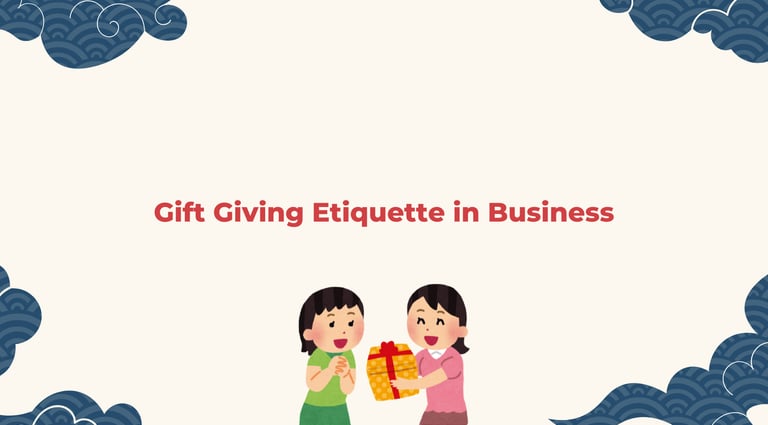

Gift Giving Etiquette in Business
Exchanging gifts is a common practice in Japanese business culture, though it comes with its own etiquette. If you’re visiting Japanese clients or partners, it’s thoughtful to bring a small gift from your home country – something unique but not overly expensive. Western companies often bring items like specialty chocolates, local delicacies, or a branded souvenir from their city. Such gifts acknowledge the hospitality you receive and signal goodwill. For instance, if you’re from California, a box of locally made chocolates or a book of scenic photography from your region can be good choices. Ensure your gifts are professionally wrapped (presentation matters – many department stores in Japan offer gift-wrapping service if you need a last-minute option).
When and how to give the gift? If it’s an initial courtesy visit, people often hand over gifts after the formal introductions and business card exchange, not immediately upon walking in (so it doesn’t seem like a bribe)shinka. You might say, “This is a small token of appreciation from our team in [your country].” Offer it with both hands and a slight bow. It’s polite to demur verbally when giving something of value – for example, a humble phrase in Japanese like “Tsumaranai mono desu ga…” (literally “It’s an insignificant thing, but please…”) or “Hon no o-miyage desu” (“just a little souvenir”). These phrases reflect humility and that you’re not assuming your gift is grand.
Receiving gifts: Chances are your Japanese counterparts will also give you gifts – perhaps at the end of a meeting or during a dinner. Accept any gift with enthusiastic gratitude, using both hands and saying thank you (“Arigatō gozaimasu”). It is actually polite in Japan to initially refuse a gift once or twice before accepting it. This confused me the first time I presented a gift: my Japanese colleague waved his hands and said “Oh, you shouldn’t have!” multiple times. I worried I’d offended him, but I later learned he was following custom. In Japan, it’s customary to politely protest a bit (“Oh, this is too much!”) before eventually accepting. So don’t be alarmed if your gift is not taken immediately – they will likely relent after a couple of polite refusals. Similarly, if you’re offered a gift, you might show modest hesitation (“Thank you, but you didn’t have to!”) briefly, then accept graciously.
Should you open a gift on the spot? In many Western cultures, opening a present immediately is expected, but in Japan the etiquette can vary. In formal business settings, the norm is actually not to unwrap a gift in front of the giver, so you don’t risk the giver losing face if the gift isn’t lavish. Instead, thank them and set it aside to open later in private. However, if a Japanese host gives you something and encourages you to open it (they might say “Please, go ahead and open it”), then it’s okay to do so – carefully and appreciatively. When in doubt, a good approach is to ask lightly, “Would you like me to open it now?” Otherwise, assume you’ll open it afterward. If you’re the giver and they open it immediately, don’t be surprised – they’re likely doing so to show excitement and appreciation. Just follow their lead and express happiness that they like it. And if they don’t open it in front of you, don’t push them; that’s perfectly polite in their culture.
A final tip: avoid overly extravagant or personal gifts. Expensive gifts can cause embarrassment or an obligation to reciprocate. Also steer clear of certain items with cultural baggage (for example, in Japan, giving a set of four of something is avoided because “4” can sound like “death” in Japanese – if you bring gifts, a set of three or five is better than four). A safe, thoughtful category is food – high-quality sweets, regional snacks, or anything the whole office can share are hitsshinka. Whatever you choose, the old adage “it’s the thought that counts” truly applies. Show that you put thought into it, present it politely, and you’ll be fine.
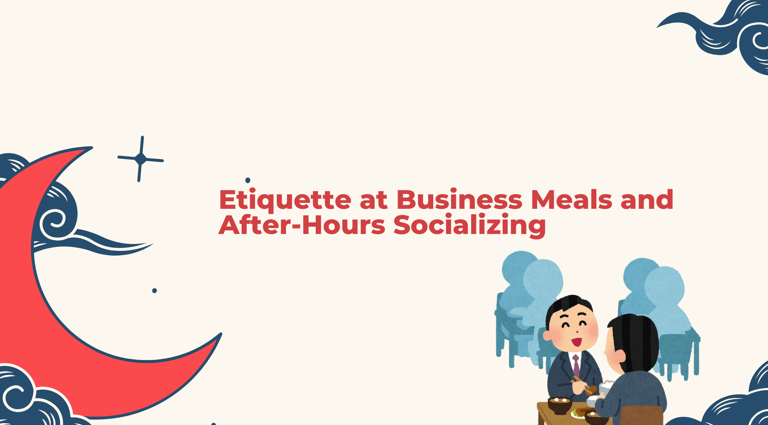

Etiquette at Business Meals and After-Hours Socializing
Business in Japan often extends beyond the boardroom. Many important discussions and relationship-building moments happen over meals and drinks. If you’re invited to a lunch, dinner, or an after-work nomikai (drinking gathering), consider it an honor – it means your Japanese counterparts are interested in deepening the relationship. However, these situations come with their own set of manners. Here’s how to navigate a Japanese business meal with politeness and confidence:
Seating and starting the meal: Much like in meetings, wait for cues. In a formal restaurant setting, there may be a predetermined seating order (guest of honor sits in a particular spot – often facing the door, or simply the best seat). Let your host direct you where to sit. Once seated, you should generally wait for the host or the eldest person to start the proceedings. It’s customary to begin with a toast, especially at dinner. Do not start drinking (or eating) until everyone is served and someone leads a toast. Usually the host will say “Kanpai!” (cheers) while everyone raises a glass. Join in with a smile and a “Kanpai!” as you gently clink glasses or (if it’s a large group) simply raise your glass and nod toward those near you. A common faux pas is reaching for your beer and taking a sip before the toast – to Japanese eyes, that looks impatient and rude. So even if you’re parched, hold off until the communal “cheers.”
Another tidbit: when clinking glasses, it’s polite to clink at a slightly lower height than your superior’s glass as a sign of respect. It’s a small nuance – if they’re significantly older or higher rank, you defer by not raising your glass higher than theirs.
Eating etiquette: Many Western businesspeople worry about using chopsticks correctly. If you’re not adept, it’s okay – the key is to try and to be graceful about it. Don’t dramatically ask for a fork right away if you can help it. If you truly need utensils, your hosts will likely notice your struggle and kindly offer you a fork or spoon. Asking directly could embarrass them (they might feel they failed as hosts for not anticipating your need). So give it a go with chopsticks, and if it’s not working out, a gentle admission like “I’m still learning how to use chopsticks” will prompt assistance. Never stick your chopsticks vertically into a bowl of rice – this resembles a funeral rite and is considered very bad form. Instead, if you need to put chopsticks down, lay them on the holder or across your bowl. Also, avoid using chopsticks to gesture or spear food; pick things up cleanly (or ask for serving utensils if needed).
When served soup or rice in a small bowl, it’s polite to pick up the bowl and drink or eat from it directly, using chopsticks to guide solid pieces. Slurping noodles (like ramen) is acceptable in Japan (it’s seen as enjoyment), so don’t be shocked if your dinner partners noisily enjoy their noodles. You can give a little slurp yourself – it won’t be seen negatively. On the other hand, blowing your nose at the table is considered quite rude – if you must, excuse yourself to the restroom. As for conversation, follow your host’s lead: some business dinners stay formal, but many are an opportunity to relax and bond. It’s okay to discuss family (in general terms) or hobbies if they bring it up, but often initial dinners still avoid deeply personal topics. Safe topics include how you like Japan so far, places you visited, or asking for recommendations on things like food or travel in Japan.
Drinking etiquette: If alcohol is involved (and often it is, especially beer, sake or whiskey in business dinners), there are a few golden rules. First, do not pour your own drink. In Japan, it’s customary for people to pour for each other as a sign of hospitality. You should let others pour beverage into your glass, and you should return the favor by keeping an eye on your companions’ drinks and offering to refill them when they’re getting low. Typically, the junior person will pour for seniors first, but as an honored guest you might find others eagerly topping you up. Use both hands when pouring for someone (one hand to hold the bottle, the other steadying or touching your arm) and also when holding your glass for someone to pour for you. For example, if a colleague is refilling your beer, you would lift your glass up off the table, hold it with one hand while lightly supporting the bottom or side with your other hand, and thank them as they pour. It’s a graceful little two-handed gesture that shows you appreciate their courtesy.
One common scenario is that your Japanese host may keep refilling your glass after every few sips. They are being polite and making sure you never have an empty glass. If you’ve had enough, leaving the glass full is a subtle way to decline more (they won’t pour if it’s full). Similarly, you should try to refill others’ glasses, especially the seniors or the person who invited you. If they refuse, they’re likely just being modest – offering once or twice more is okay (“Please, allow me”). Often, a Japanese colleague will politely say “iin desu, iin desu” (I’m good, I’m fine) a couple of times; a gentle insistence like “Osomatsu-sama desu ga...” (“It’s nothing special, but please”) might lead them to accept your pour on the second or third offer. It’s a little dance of courtesy. However, do learn to recognize a firm no – if they cover the glass or insist strongly, then stop.
Know your limits: While Japanese business drinking culture can be quite enthusiastic (the term “nomunication” = nomi [drink] + communication, highlights how important after-work drinks can be for bonding), you are not obligated to get drunk. Pace yourself. It’s acceptable to nurse a beer or even request a non-alcoholic beverage if you don’t drink alcohol – just do so in a low-key, courteous way (for instance, saying you’re not drinking tonight for health or that you’d prefer soda is fine, especially with the younger generation). If you have a drink, even a small amount, it shows willingness to participate. But never pressure anyone else to drink, and if you are feeling pressured, politely say something like “I have an early meeting tomorrow, I’ll stick to one drink” and keep that glass full so it doesn’t get refilled.
Paying the bill: In professional settings, the one who extended the invitation (often the Japanese side if you’re their guest) will typically pay, and the exchange is usually handled discreetly by the host with the restaurant staff. It’s not customary to split the bill in a formal business dinner. You can offer once to pay or contribute, but don’t insist too much – let your host have the honor of treating you, and thank them genuinely. In turn, you can offer to treat next time or reciprocate with a gift. (Among close colleagues or friends in Japan, splitting the bill evenly – warikan – or each paying for their own is common, but in business hospitality, the inviting party pays.) Also, tipping is not practiced in Japan. If you leave extra cash, the waiter will likely come running to return it, as service is considered included. So don’t tip, and do express appreciation to the staff with a smile and an “Arigatō.”
By following your hosts’ lead during meals and remembering these pointers – wait for kanpai, pour for others, handle chopsticks and table manners with care – you’ll not only avoid rudeness, but you’ll also show that you’re keen to embrace Japanese culture. Many a partnership in Japan has been solidified over a long dinner and rounds of drinks. These social moments are where your Japanese counterparts may open up a bit more. Relax and enjoy them (within the bounds of decorum), because as the saying goes, sometimes “business is done on the izakaya (pub) table rather than the boardroom.” Your genuine effort to participate respectfully in these after-hours traditions will make a lasting positive impression.
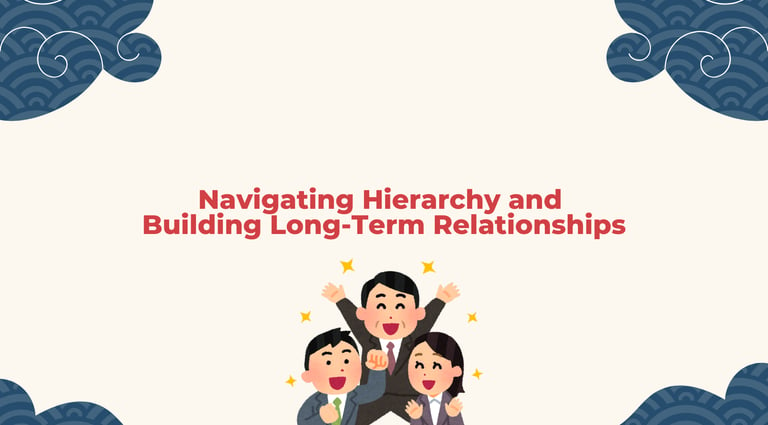

Navigating Hierarchy and Building Long-Term Relationships
Underpinning all of the above etiquette is a fundamental aspect of Japanese business culture: respect for hierarchy and patience in building relationships. In Japanese companies, age and rank are given great deference. You’ll notice deference in how people speak (using honorific language, or keigo, to seniors), how they exchange business cards (senior executives go first), where they sit, and even how low they bow. As a foreign businessperson, you aren’t expected to use honorific Japanese, but you should show respect to senior members of the team. This can be as simple as standing when a high-ranking person enters the room, giving a slight bow when handing something to them, or acknowledging their statements with extra respect.
Be mindful that the decision-maker might not be the person chatting with you most in meetings. Often, the higher-ups may sit quietly while juniors do the talking and translation. Don’t mistake the most fluent English-speaker in the room for the ultimate boss – they might actually be a mid-level staffer tasked with communication. Ensure you greet and acknowledge the top executives even if they speak less. For example, if you know who the President or section chief is, make a point to hand your business card to them first and thank them at the end of the meeting. After a meeting, it’s good practice to send a follow-up email thanking the group, and it’s wise to cc or specifically mention the senior member to show you recognize their importance (even if Tarō from sales did all the talking).
Finally, understand that trust in Japan is built over time – often a long time. Your Japanese counterparts may seem a bit reserved or formal with you for months or even years. This isn’t a sign of dislike; it’s just the culture. As one saying goes, Japanese might not fully trust a business partner until having worked together for 10 years or more. That doesn’t mean your deals will take a decade to happen, but it means personal rapport grows gradually. Don’t rush into personal topics like family or prying into their private life in early meetings – many Japanese professionals keep business and personal separate, until a genuine friendship has formed. They may not readily invite you to their home or talk about their weekend initially. This formal distance can persist even as you share laughs over drinks. It’s just their way of maintaining professionalism. Do not take it as a snub. The best approach is to show up consistently respectful, follow through on promises, and demonstrate your reliability over time. Consistency and honor in actions speak louder than any effusive small talk.
One Western startup founder learned this the hard way: after a couple of meetings and friendly dinners with a Japanese client, he assumed they had become “buddies” and started addressing the client by first name and making jokes as he would with an American peer. The client remained polite but noticeably stiff. Only later did a Japanese colleague explain that the relationship was not yet at that level of informality – the founder had skipped stages in the eyes of the client. The takeaway: err on the side of formality and conservative behavior. Over time, your Japanese partners will signal if things can relax – perhaps after several successful projects and many shared meals, they’ll say “Call me Yoshi” or invite you to a family event. Until then, maintain the polite protocols and you’ll be respected as a person who “gets it.”
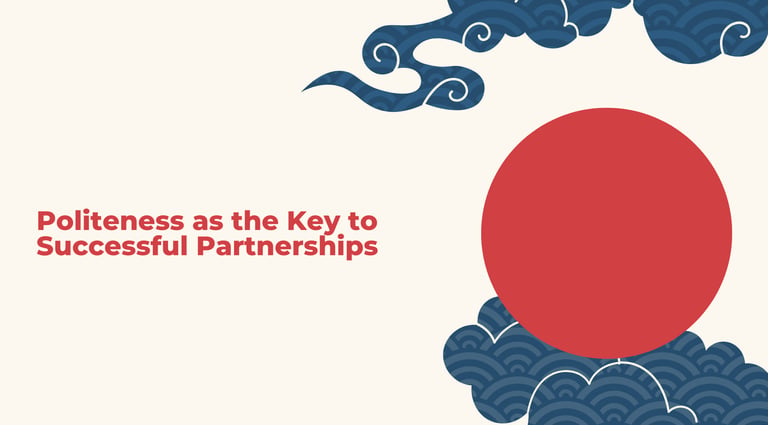

Conclusion: Politeness as the Key to Successful Partnerships
Doing business in Japan can be incredibly rewarding. The market is huge, the technology and quality standards are world-class, and you’ll meet wonderful people. By mastering the points of politeness covered in this guide – from the graceful bow at the greeting, the careful exchange of meishi, and the art of a well-timed kanpai, to the nuanced reading of “yes means maybe” – you equip yourself to navigate Japanese business culture with confidence. Remember that as a foreigner, Japanese colleagues will generally forgive minor missteps; they know you can’t be expected to know every rule. What they value most is your sincerity and effort. A little bow, a properly treated business card, or a moment taken to say “thank you” in Japanese can earn you big respect because it shows you care about their way of doing things.
In Japan, etiquette isn’t about stiff rules to trap outsiders – it’s about creating an atmosphere of mutual respect so everyone feels comfortable. As the Japanese proverb “When in a village, follow its customs” suggests, showing adaptability is seen as a sign of wisdom. By following the guidelines above, you won’t come across as the bullish Westerner who barges in oblivious to local norms, but rather as a considerate partner worth trusting. And trust, once earned, runs deep. Japanese partners, once they truly trust you, can become the most loyal clients or allies you’ll have.
To recap, approach each interaction with a dose of humility: listen well, observe others’ cues, and don’t assume Western norms apply. If unsure, do as the Japanese do – or politely ask for guidance. Your counterparts will often be happy to explain a custom if you show genuine interest (which could even turn into a bonding moment). Over time, you might even come to appreciate the elegance of Japan’s business etiquette – the subtle dance where everyone knows their part, aimed not at stifling business but at oiling the wheels of collaboration.
In summary, politeness is the “open sesame” to building business success in Japan. It signals respect, breaks down barriers, and lays the groundwork for long-term relationships. Combine your professional expertise with cultural respect, and you’ll find Japanese partners opening up to you in ways that can propel your ventures to new heights. So bow, exchange that meishi, say “yoroshiku onegaishimasu,” and embrace the process – your efforts will speak volumes in any boardroom from Tokyo to Osaka. Ganbatte kudasai (do your best) and good luck in your Japanese business endeavors!


River Chan is a marketing director of ToAsia.biz with over 10 years of experience in marketing from strategic planning, project execution, and data analysis across different industries.
About Author
Copyright © 2025 ToAsia.biz


We lead your business to Asia
Our Business Growth Experts help SaaS businesses achieve growth in Asia and become profitable FAST.
Send us a message via WhatsApp
